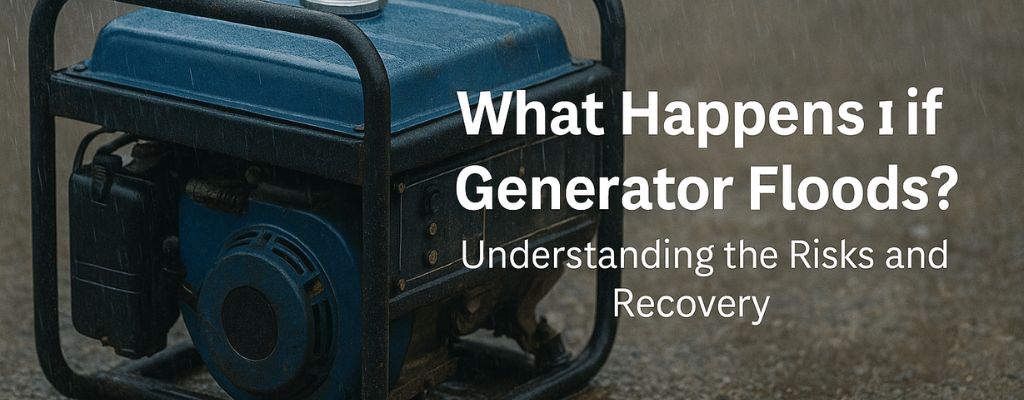
What Happens if My Generator Floods?
If your generator floods, it’s basically a soggy, expensive paperweight — water can cause corrosion, short circuits, and a complete shutdown. But don’t panic just yet. With the right steps, you can often bring it back to life. Stick around for tips to get your power hero running again.

Immediate Dangers and Initial Steps for a Generator Flooded with Water
Generator Flooded with Water: The Primary Concern of Electrical Hazards
A wet generator isn’t just inconvenient — it can be dangerous. Water inside electrical parts creates the perfect setup for sparks, shorts, and nasty shocks.
Risk of Short Circuits and Electrocution from a Wet Generator
When water gets into live wiring or circuits, it can fry your components or give you a serious zap. It’s not worth taking the risk, even for a quick peek.
Importance of Disconnecting Power Before Approaching a Flooded Generator
Before you do anything else, cut the power and shut off the fuel supply. That simple move removes the biggest safety threats and stops further damage while you check things over.
Engine Hydro-Lock: A Catastrophic Event for Your Flooded Generator
How Incompressible Water Causes Severe Internal Engine Damage to Your Generator
Engines are designed for air and fuel — not water. If water gets into the cylinders, it can’t be compressed, which means bent rods, cracked pistons, or a completely ruined engine.
Signs of Hydro-Lock in a Flooded Generator (e.g., sudden stop, inability to crank)
If your generator suddenly stops during a flood, refuses to crank, or makes a dull thud when you try to start it, you might be dealing with hydro-lock.
Contamination of Fuel and Oil Systems in a Flooded Generator
Water Mixing with Fuel and Lubricants in Your Generator's System
Floodwater can easily get into the fuel tank or oil reservoir. Once mixed, your clean fluids turn into a sludgy mess that can’t lubricate or ignite properly.
The Impact of Contaminated Fluids on Your Generator's Performance and Lifespan
Dirty fuel and oil cause rust, blockages, and poor combustion. Leave it long enough and you’ll shave years off your generator’s life.

What Happens if My Generator Floods and Won’t Start? Diagnosing Damage
Flooded Generator Won’t Start: Common Reasons After Water Exposure
Water in the Carburettor or Fuel Lines Preventing Your Generator from Firing
Water in the carburettor or fuel lines disrupts the fuel–air mix. Without the right balance, your generator simply won’t fire up.
Electrical System Damage Inhibiting Your Generator's Ignition
If moisture reaches the spark plug, ignition coils, or wiring, it can block the spark entirely.
Corrosion and Rust: Long-Term Threats to a Water-Damaged Generator
How Moisture Accelerates Degradation of Metal Components in Your Generator
Water doesn’t just sit there — it starts eating away at metal almost immediately. The longer it lingers, the worse the damage.
Specific Areas Vulnerable to Rust in a Flooded Generator (e.g., fuel tank, engine parts)
The fuel tank, cylinder walls, and crankshaft are all prime rust targets. If not dried quickly, you’ll be dealing with permanent damage.
Damage to Electrical Components and Control Systems of Your Generator
Vulnerability of Wiring, Sensors, and Circuit Boards in a Wet Generator
Wiring, sensors, and delicate circuit boards are especially vulnerable. Even a little moisture can cause them to fail or behave unpredictably.
The Challenge of Drying and Restoring Complex Electronics in a Flooded Generator
Electronics are tricky to dry properly. Without the right tools, there’s a real risk of hidden moisture causing trouble later.
Alternator and Winding Damage in a Flooded Generator
How Water Can Compromise the Insulation of Your Generator's Windings
Floodwater can strip away insulation from copper windings. This increases the risk of short circuits and reduces efficiency.
The Potential for Costly Rewinding or Replacement of a Water-Damaged Generator Alternator
If the alternator is badly damaged, rewinding or replacing it can be one of the priciest repairs you’ll face.

How to Fix a Flooded Generator: Recovery Steps and Prevention
Initial Recovery Actions for Your Flooded Generator (If Not Running)
Draining Contaminated Fluids (Fuel, Oil) from Your Generator
Drain any water-tainted oil or fuel immediately. Refill with clean fluids to protect the internal parts from further harm.
Thorough Drying of All Accessible Components of Your Generator
Use a wet/dry vacuum, absorbent cloths, and plenty of airflow to remove moisture. Skip the heaters and blowtorches — they can cause more damage than they solve.
Professional Assessment and Repair for a Severely Flooded Generator
When to Call a Qualified Technician for Your Water-Damaged Generator
If you suspect hydro-lock, alternator damage, or electrical issues, get a professional involved. They can diagnose and repair issues you might miss.
Understanding the Economic Viability of Repairing a Severely Flooded Generator
Sometimes it’s cheaper to replace the generator entirely rather than fix multiple major components. A pro can help you weigh the costs.
Preventing Future Flooding: Protecting Your Generator from Water
Strategic Placement and Elevation of Your Generator
Mount your generator on a raised, stable platform, well above known flood levels.
Using Protective Enclosures and Shelters for Your Generator in Flood-Prone Areas
A waterproof, ventilated enclosure is worth the investment. It keeps rain and floodwater out while still letting the machine breathe.
Conclusion: Protecting Your Generator from Water Damage is Paramount
Water and generators don’t mix — literally or figuratively. Acting quickly, drying thoroughly, and taking preventive steps can save you a lot of money and hassle. Keep your generator high, dry, and ready for action when you need it most.


